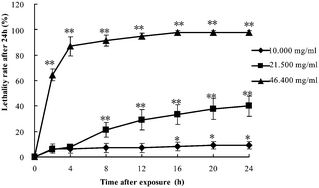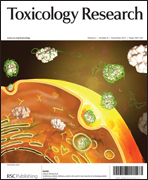Correlation of chemical acute toxicity between the nematode and the rodent
Abstract
The utility of any non-rodent model system for chemical toxicity screening depends on the level of correlation between its responses and toxic reactions in rodents. Toxicity assays in the nematode Caenorhabditis elegans (C. elegans) can be fast and inexpensive; however few studies have been performed comparing toxic responses in the nematode with data on acute rodent toxicity. We assayed the acute toxicity of 21 types of chemicals in different toxicity categories using C. elegans. The nematodes were exposed to different concentrations of chemicals in 96-well plate for 24 h. The lethality rate was observed at 2, 4, 12 and 24 h, and median lethal concentration (LC50) was calculated by the Probit method. The lethality rate was counted at 1, 8, 16 and 20 h additionally at the concentrations of 10.000, 21.500 and 46.400 mg ml−1 to acquire median lethal times (LT50). The results indicated that the chemical pH could affect the C. elegans LC50 value. The pH toleration range for C. elegans was more than 2.75. Excluding 4 types of acidic chemicals, there were positive correlations between LC50s of C. elegans and LD50s of mouse/rat (r > 0.72, p < 0.01) after both 12 h and 24 h exposure. As to the LC50 data following a 24 h exposure in C. elegans, the correlation of C. elegans LC50s vs. rat LD50s (r = 0.885) was greater than the correlation of mouse vs. rat LD50s (r = 0.879), while the correlation of C. elegans LC50s vs. mouse LD50s (r = 0.741) was lower relative to that of mouse vs. rat LD50s. The data were further compared with an in vitro cytotoxicity model utilizing human epidermal keratinocytes (NHK). The data indicate that the correlation of C. elegans LC50s vs. rat LD50s was equal to the correlation of mouse vs. rat LD50s (r = 0.879), and was stronger than the correlation of NHK cell IC50s vs. rat LD50s (r = 0.844). In addition, LT50 was significantly correlative with the LC50 of C. elegans, indicating that both can be utilized as toxic effect index for further study on acute toxicity testing of chemicals. In summary, C. elegans may be a valuable model for predicting chemicals’ acute toxicity in rodents.


 Please wait while we load your content...
Please wait while we load your content...